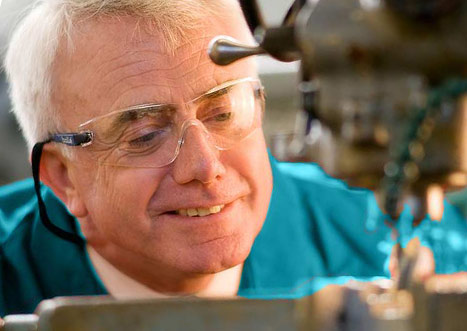
Become an Apprentice
Engineering Apprenticeships offer you the opportunity to gain a nationally recognised qualification, whilst being in employment.

Upon arriving on site, I make sure I have all the correct PPE, this includes such things as my high visibility clothing, safety boots and safety glasses, before entering the body shop. I then clock in and ‘job on’ to a specific job I will be doing for the day - such as bus door conversions. Before approaching the job, I unlock my toolbox and make sure I have all the tools needed for the specific tasks ahead.
Tasks can include cutting a portion out of the side of the bus to allow a new door to be fitted, or fabricating a structure to build another side of the bus, cutting up aluminium box section to create a waste rail and pillars to support the side of the bus. It can also includes measuring and cutting mild steel box section and welding to support the floor.
If I am fabricating a side of a bus, I need many tools to make sure my measurements are precise and accurate as this is important when engineering this part of the bus. Tools for this will include a measuring tape, set square and scriber to mark the aluminium to make it stand out clearly. To cut the aluminium to the correct size I set up the big guillotine to get a clean cut and them de-burr any sharpe edges.
For a welding task, I need to make sure the area I am working in is screened off to prevent flashes from damaging other employees’ eyes. I make sure I have the correct PPE such as my welding mask with respirator/extraction filter, gauntlets and jacket to prevent any burns. Before welding I need to clean the sections that are going to be welded using air tools such as a grinder or sander. These are very loud therefore I use ear defenders. Welding equipment needs to be checked before it is used, therefore I fill out a checklist for the MIG welder. Once I have checked it off, I can set the machine up to the correct settings for gas, wire speed and amperage depending on the material thickness which is usually 3mm thick.
When the day is nearly over, I need to make sure I clean up any area I have worked in so that it is safe and tidy for the next person or the next day. This means sweeping up an area or making sure all my tools are returned to my tool box.
I think it’s important to be determined and enthusiastic as this helps me to complete tasks that I am given throughout the day. I think organisation plays a big part of my role as I need to anticipate what tools are suitable for each job, and what will be required to effiently complete the tasks.
Other important personal qualities include having good concentration and being able to pay attention to detail. Many tasks include measuring, marking out and cutting where you need to be accurate and precise, especially when you are working to fractions of millimetres.
I first became interested in engineering due to the ‘hands on’ approach they offer. I’ve always been more interested in with working with my hands and keeping myself busy, whether it is working on my bike when I was younger or working on my car.
I also find the design aspect of engineering interesting because it allows me to be creative. I have always been interested in how objects are put together. If my parents bought something new for the house, like a new piece of furniture, I would be the one to build it.
One of the personal highlights has been working on a project where we turned a double decker bus into an ‘open top’ bus. This involved cutting the roof off the double decker bus and then rebuilding the main structure on the top deck to make it safe. The front end of the top deck was redesigned to make it more aesthetically pleasing. This meant fabricating pillars around the windows which had been designed to be curved.
As it is an open top bus it needed a proper drainage system which meant drilling through different parts of the second floor of the vehicle and feeding pipes to act as run-offs. These needed to be sealed. The whole rear end of the bus needed to be redesigned to make it open top. This meant re-shaping the fibre glass and inserting spigots to support the safety rails that would later be installed.
Because it is challenging, practical and hands on. Each day I may encounter a new or different task that requires particular techniques to complete it. I would recommend being an apprentice because you get to learn a variety of skills and continue to do so throughout the apprenticeship. I have been able to use equipment and machines that I would not have had the opportunity to do so anywhere else safely. Being safely trained and ultimately qualified in their use will stand me in good sted for my future career path.


Engineering Apprenticeships offer you the opportunity to gain a nationally recognised qualification, whilst being in employment.

SETA help you recruit the right person to choosing the appropriate qualifications and supporting you throughout the Apprenticeship.
